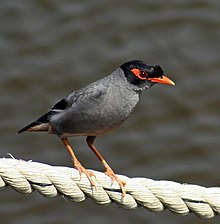Bank myna
| Bank myna | |
|---|---|
 |
|
| Near the Ganges at Bithur | |
| Scientific classification | |
| Kingdom: | Animalia |
| Phylum: | Chordata |
| Class: | Aves |
| Order: | Passeriformes |
| Family: | Sturnidae |
| Genus: | Acridotheres |
| Species: | A. ginginianus |
| Binomial name | |
|
Acridotheres ginginianus (Latham, 1790) |
|
Bank myna (Acridotheres ginginianus), called "Sharak" in Punjabi, is a myna found in northern parts of South Asia. It is smaller but similar in colouration to the common myna but differs in having a brick red bare skin behind the eye in place of yellow. It is greyer on the underside and in this and in the presence of a slight tuft of feathers bears some resemblance to the jungle myna. They are found in flocks on the plains of northern and central India, often within towns and cities. Their range appears to be extending southwards in India. The name is derived from their habit of nesting almost exclusively in the earthen banks of rivers where they excavate holes and breed in large colonies.
The head is black on the crown and sides and the upper plumage is slaty grey while the underside is lighter grey with pale pink plumage towards the centre of the abdomen. The wing is black but has a wing patch at the base of the primaries and the tips of the outer tail feathers are pale pinkish buff. The naked skin behind the eye is brick red, the legs are yellow while the iris is deep red. The sexes are indistinguishable in the field. Young birds have a browner head and neck.
The species is evolutionarily closest to the common myna.
The native range of the bank myna is almost restricted to the Indian subcontinent from the Indus valley in the West, to the Gangetic delta in the East and south of the lower foothills of the Himalayas, only rarely being found in sheltered valleys. They are found mainly in the vicinity of open water and their usual habitat is cultivated farmland and open country but flocks will often live within cities, in markets and railway stations. They make use of food scrap disposed by humans, even following catering vehicles at airports to standing aircraft.
The distribution was formerly noted to be restricted north roughly of a line between Bombay and Balasore in Orissa, but the species may be expanding its range. They are also common in Pakistan in the districts of Sind and Punjab. A specimen from Kandahar was earlier considered the westernmost record a vagrant, but the birds have since established in the region. Although mainly resident, they make movements in response to food and weather. The species name of the bird is based on the name given by Latham from a description by Pierre Sonnerat who described Le petit Martin de Gingi in 1782, referring to Gingee near Pondicherry in southern India.Thomas C. Jerdon noted in 1863 that the species did not occur in southern India however the species was recorded in the region in 1914 at Vandalur near Madras. Records from further south in India are however increasing. Breeding colonies have been found in Assam.
...
Wikipedia

